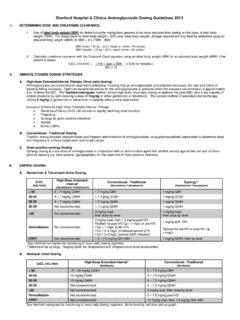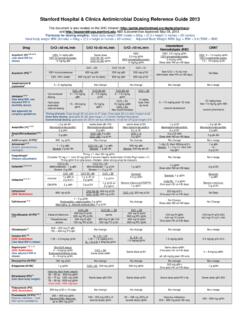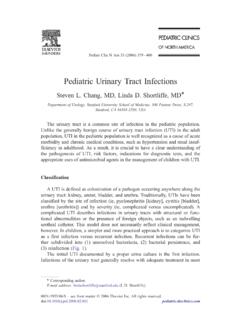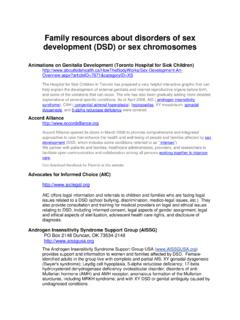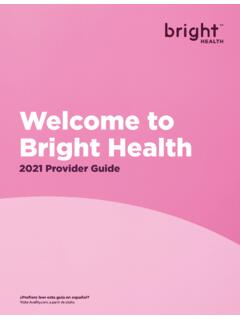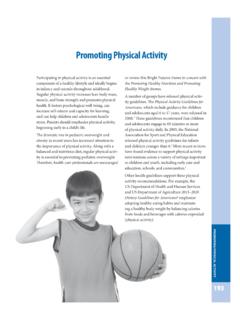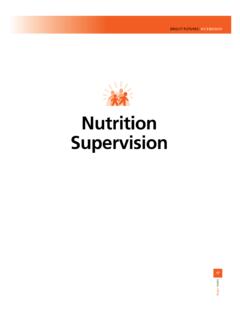Transcription of Bright Futures - Stanford University School of Medicine
1 Bright FUTURESG uidelines for health Supervision ofInfants, Children, and AdolescentsTHIRD EDITIONPOCKET GUIDEE ditorsJoseph F. Hagan, Jr, MD, FAAP Judith S. Shaw, RN, MPH, EdD Paula M. Duncan, MD, FAAPFUNDED BYUS Department of health and Human ServicesHealth Resources and Services AdministrationMaternal and Child health BureauPUBLISHED BYThe American Academy of Pediatrics CITE ASHagan JF, Shaw JS, Duncan P, eds. 2008. Bright Futures : Guidelines for health Supervision of Infants, Children, andAdolescents,Third Edition. Pocket Grove Village, IL: American Academy of 2008 by the American Academy of Pediatrics. All rights reserved. No part of this publication may be reproduced, stored in a retrieval system, or transmitted, in any form or by any means, electronic, mechanical, photo-copying, recording, or otherwise, without prior written permission from the of Congress Catalog Card Number: 2007929964 ISBN-13: 978-1-58110-224-6 ISBN-10: 1-58110-224-0BF0027 PUBLISHED BYAmerican Academy of Pediatrics 141 Northwest Point BlvdElk Grove Village, IL 60007-1098 USA847-434-4000 AAP Web site: Futures Web site: copies of this publication are available from the American Academy of Pediatrics Online Bookstore This publication has been produced by the American Academy of Pediatrics under its cooperative agreement(U06MC00002) with the US Department of health and Human Services, health Resources and Services Administration(HRSA), Maternal and Child health Bureau (MCHB).
2 IiiTA B L E O F C O N T E N T S Bright Futures at the American Academy of to Use This Effective Partnerships .. xFostering Family-Centered Communication .. xiPromoting health and Preventing Illness.. xiiManaging Time for health Promotion .. xiiiEducating Families Through Teachable Moments .. xivAdvocating for Children, Families, and Communities .. xvSupporting Families and Youth With Special health Care Needs .. xviiCultural Competence .. xviiComplementary and Alternative Care .. xviiiBright Futures Futures health Supervision Used in the Bright Futures health Supervision Visits.. 1 Prenatal Visit .. Week Visit .. 61 Month Visit .. 82 Month Visit.. 126 Month Visit.. 1612 Month Visit .. 1815 Month Visit .. 2018 Month Visit .. 222 Year Visit.. 24212 Year Visit.. 263 Year Visit.. 284 Year Visit.. 305and 6 Year Visits .. 327and 8 Year Visits .. 349and 10 Year Visits.
3 38 Early Adolescence (11 to 14 Year Visits) .. 42 Middle Adolescence (15 to 17 Year Visits).. 46 Late Adolescence (18 to 21 Year Visits) .. Milestones at a Glance Milestones at a Glance Early and Emotional Development in Middle Childhood .. 56 Domains of Adolescent Development .. 57 Recommended Medical Screening Medical Screening Early Childhood .. 59 Recommended Medical Screening Middle Medical Screening Adolescence .. 61 Tooth Eruption Chart .. 62 Sexual Maturity Ratings .. 63 Useful Web Sites .. 64vBright Futures at the AmericanAcademy of Pediatrics Founded in 1930, the American Academy ofPediatrics (AAP) is an organization of 60,000 pedia-tricians who are committed to the attainment ofoptimal physical, mental, and social health and well-being for all infants, children, adolescents, and youngadults. The Bright Futures initiative was launched in 1990under the leadership of the Federal Maternal and ChildHealth Bureau (MCHB) of the health Resources andServices Administration (HRSA) to improve the quality ofhealth services for children through health promotion anddisease prevention.
4 In 2002, the MCHB selected the AAPto lead the Bright Futures initiative. With the encourage-ment and strong support of the MCHB, the AAP and itsmany collaborating partners set out to update the BrightFutures Guidelinesas a uniform set of recommendationsfor health care professionals. The Bright FuturesGuidelinesare the cornerstone of the Bright Futures initia-tive and the foundation for the development of all BrightFutures Is Bright Futures ? Bright Futures is a set of principles, strategies, and toolsthat are theory based, evidence driven, and systems oriented that can be used to improve the health andwell-being of all children through culturally appropriateinterventions that address their current and emerginghealth promotion needs at the family, clinical practice,community, health system, and policy of Bright Futures !Enhance health care professionals knowledge, skills,and practice of developmentally appropriate health carein the context of family and community.
5 !Promote desired social, developmental, and health outcomes of infants, children, and adolescents.!Foster partnerships between families, health carepro-fessionals, and communities.!Increase family knowledge, skills, and participation inhealth-promoting and prevention activities.!Address the needs of children and youth with specialhealth careneeds through enhanced identification moreinformation about Bright Futures and available materials and resources, visit http:// to Use This GuideThe Pocket Guideis based on Bright Futures :Guidelines for health Supervision of Infants,Children, and Adolescents,Third Edition. Presentingkey information from the Guidelines, the Pocket Guideserves as a quick reference tool and training resource forhealth care of the Pocket GuideThemes: Highlights 10 cross-cutting child health topicsthat arediscussed in depth in the Guidelines. Thesethemes are important to families and health care profes-sionals in their mission to promote the health and well-being of all children.
6 The Pocket Guidelists these themes;see the Guidelines for the full health Visit: Focuses on specific age-appropriatehealth and developmental Priorities:The Bright Futures Expert Panels acknowledge that the most important priority is to attend to the concerns of the parent or youth. In addi-tion, they have developed 5 priority health supervisiontopics for each Observation:Includes observation ofparent-child interaction, developmental surveillance, andschool performance Exam:Recommends a complete physical exam, including specific issues for each :Includes universal and selective screening procedures and risk :Provides Centers for Disease Controland Prevention/National Immunization Program andAmerican Academy of Pediatrics Red BookWeb sites forcurrent Guidance:Presents guidance for families, organized by the 5 priorities of each questions also are provided for selected and questions in blacktype are intended forthe parent; guidance and questions in greentype areintended for the child/adolescent/young adult.
7 These canbe modified to match the health care professional s communication style. viiiAppendices:Includes developmental milestones at-a-glance charts for infancy and early childhood, a chart onsocial and emotional development in middle childhood, achart on domains of adolescent development, recommended medical screening tables, a tooth eruptionchart, a sexual maturity ratings chart, and a list of usefulWeb sites. ixCore Concepts Intoday s complex and changing health care system, health care professionals can improve the way theycarry out each visit by using an innovative health promotion curriculum developed specifically to help professionals integrate Bright Futures principles into clinical unique curriculum, developed by a health promo-tion work group supported by the Maternal and ChildHealth Bureau, includes 6 core concepts:!Partnership!Communication!Heal th promotion/illness prevention!Time management!Education!
8 AdvocacyAsummary of each of these coreconcepts is present-ed on the following pages to help all professionals, boththose in training and experienced practitioners, bringBright Futures alive and make it happen for children andfamilies. For more information about this unique healthpromotion curriculum, visit All 6 core concepts rely on the health care profession-als skills in using open-ended questions to communicate effectively, partner with and educate children and theirfamilies, and serve as their advocates to promote healthand prevent illness in a time-efficient questions!Help to start a conversation!Ask: Why? How? What? !Are interpretive!Have a wide range of possible answers!Stimulate thinking!Promote problem solvingEXAMPLES: How do you and your partner manage the baby sbehavior?What do you do when you disagree? (Toachild) Tell me about your favorite activities at !Begin with affirming : What are some games you re really good at?
9 !Wait at least 3 seconds to allow the family to respondto the question.!Ask questions in a supportive way to encourage Effective PartnershipsAclinical partnership is a relationship in which participantsjoin together to ensure health care delivery in a way thatrecognizes the critical roles and contributions of each part-ner (child, family, health care professional, and communi-ty) in promoting health and preventing illness. Followingare 6 steps for building effective health partnerships:1. Model and encourage open, supporting commu-nication with child and family.!Integrate family-centered communication strategies.!Use communication skills to build trust, respect, Identify health issues through active listening and fact finding. !Selectively choose Bright Futures Anticipatory Guidancequestions.!Ask open-ended questions to encourage more com-plete sharing of information.!Communicate understanding of the issues and Affirm strengths of child and family.
10 !Recognize what each person brings to the partnership.!Acknowledge and respect each person scontributions.!Commend family for specific health and Identify shared goals.!Promote view of health supervision as partnership between child, family, health care professional, andcommunity.!Summarize mutual goals.!Provide links between stated goals, health issues, andavailable resources in Develop joint plan of action based on statedgoals.!Be sure that each partner has a role in developing theplan.!Keep plan simple and achievable.!Set measurable goals and specific timeline.!Use family-friendly negotiation skills to ensure agreement.!Build in mechanism and time for Follow up to sustain the partnership.!Share progress, successes, and challenges.!Evaluate and adjust plan.!Provide ongoing support and Family-Centered CommunicationEffective Behaviors!Greet each family member and introduce self.!Use names of family members.

